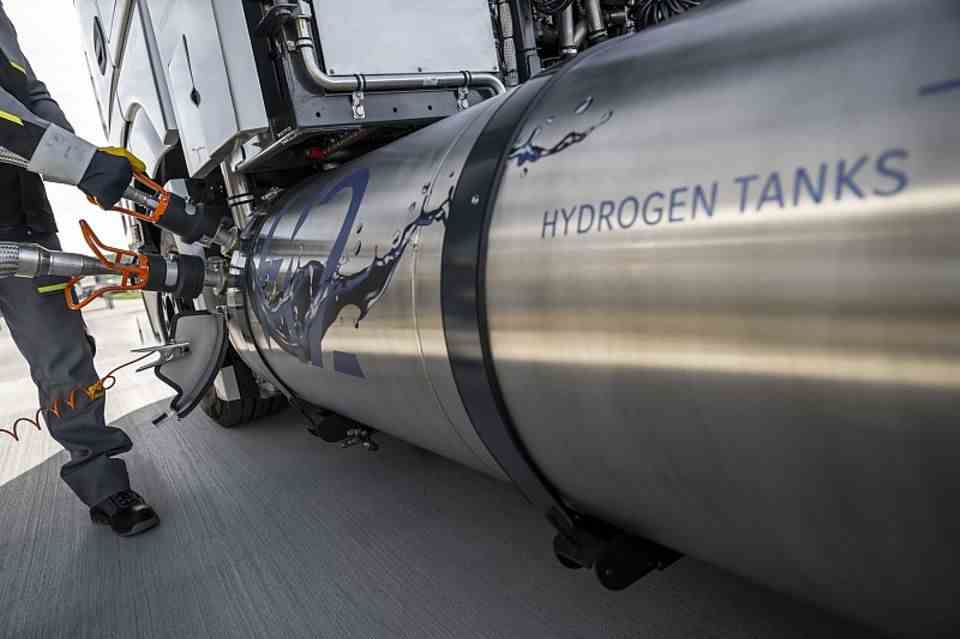Technology Daimler Truck is testing fuel cell trucks with liquid hydrogen
The die is cast
Daimler GenH2 Truck
© press-inform – the press office
Daimler Truck relies on liquid hydrogen for its heavy-duty commercial vehicles. Tests with such a hydrogen fuel cell truck are already underway. The technology should be ready for series production by 2028.
“The die is cast.” None other than Julius Caesar is said to have made this famous statement when he crossed the Rubicon with his troops, which effectively meant a civil war. Every schoolboy knows how it ended. In the case of trucks with fuel cell drives, the effects are far less far-reaching. But if Daimler Trucks has its way, the decision was made in favor of liquid hydrogen. Tests with such a truck are already underway. A new hydrogen fuel cell truck is already doing its rounds at the test center in Wörth am Rhein. incessantly. “Durability is extremely important”; explains Daimler truck development engineer Andreas Höfert. While the life cycle of a passenger car is around 300,000 kilometers and 8,000 operating hours, it is 1.2 million kilometers and 25,000 hours for a 40-ton truck. We took a seat in the driver’s cab of the GenH2 truck and experienced how quietly, quietly and unspectacularly the fuel cell tractor can be moved. That’s a big step. After all, the truck only has 350 kilometers on the clock.
With a complex technology like this, every detail counts. “We pay attention to cables, lines and of course the fuel cell,” says Andreas Höfert. This is the focus of the test drives. There seems to be increasing consensus that hydrogen will come as an energy carrier and in commercial vehicles. The first Daimler fuel cell hydrogen truck should be ready for series production in around six years. The drive has to work properly. It consists of two electric axles, each with 230 kW / 313 hp continuous output (330 kW / 449 hp maximum) and two fuel cells, each with 150 kW / 210 hp. The maximum torque of the two electric motors is 2,071 Newton meters per electric motor. Powerful. Because with the trucks, the torque is almost more important than the e-power.
Because liquid hydrogen reacts with oxygen to form pure water, the fuel cell’s bipolar plate is made of carbon composite. “It’s more robust than, for example, a metal plate with an iridium surface. It would be attacked by the pure water,” explains Dr. Florian Henkel from “cellcentric” who contribute this component. “The development is over, we have to bring the product,” demands the technician. Even if filling up with hydrogen is much faster than with batteries, every second that a truck is stationary in the logistics industry is lost time. That’s why the GenH2 truck is equipped with two stainless steel tanks, each with a capacity of 40 kilograms. That’s enough for 800 to 1,200 kilometers.
If the truck does need to be refueled, the tanks are refilled in a good twelve minutes. Refueling is not entirely trivial, because hydrogen at a temperature of minus 253 degrees is filled into the two tanks. They consist of two stainless steel shells and not carbon, which significantly reduces costs. The construction of the containers and the improved manufacturing technology make them possible to store the ultra-low temperature gas. Evaporating the hydrogen would kill the project. The tanks consist of two containers and a vacuum between them. With this structure, the hydrogen can be transported for a long time without cooling. It is important that the two containers are tight, because this is the only way to maintain the vacuum. “It’s easier to pump something than to compress a gas,” says Roland Dold, who is responsible for vehicle development at Daimler Trucks, summing up one of the reasons for this decision. The filling stations have a capacity of 400 kg hydrogen per hour so that five vehicles can be refueled during this time.
Even if transporting and handling liquid hydrogen is anything but easy, there are a number of reasons for using it in this form. At the top of the pro list is energy density. Hydrogen at 350 bar has an energy density of 24 kg per cubic meter, at 700 bar it is already 40 kg/m3 and liquid even 70 kg/m3. In addition, liquid hydrogen can be transported in various ways. The complex structure of the fuel cell reacts almost sensitively to “impure” hydrogen, which contains residues that result from transport using gas pipelines. The same applies to storage in carbon tanks. “By the way, Airbus relies on the same principle,” adds Roland Dold.
It is also clear that the liquid hydrogen is mainly suitable for the heavy guys. The 350 and above all 700 bar variants will be used for lighter commercial vehicles and passenger cars. That all sounds logical. But no matter how you look at it, hydrogen mobility only has a chance of success if the hydrogen is “green”, i.e. produced sustainably from renewable energies. “We use the Earth’s sunbelt to liquefy hydrogen on a large scale,” says Roland Dold. Even if Germany will not become energy self-sufficient in the near future, you don’t just have to rely on sunny areas. Hy2B Hydrogen GmbH is building a five-megawatt electrolyser near the Bavarian city of Landshut, using electricity from a new adjacent solar system.


